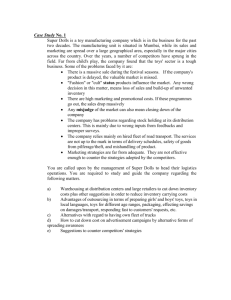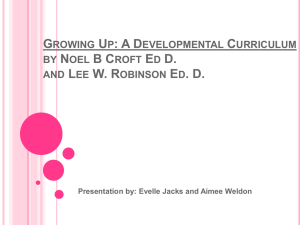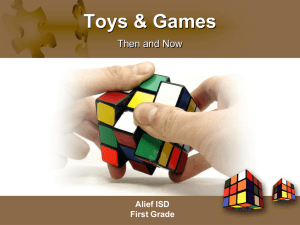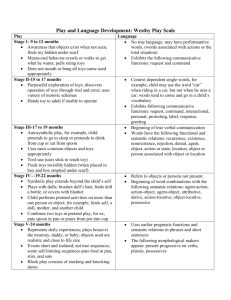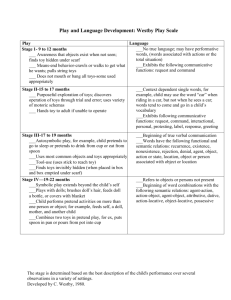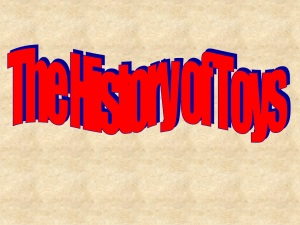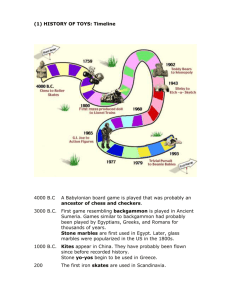Medieval Toys You Can Make
advertisement
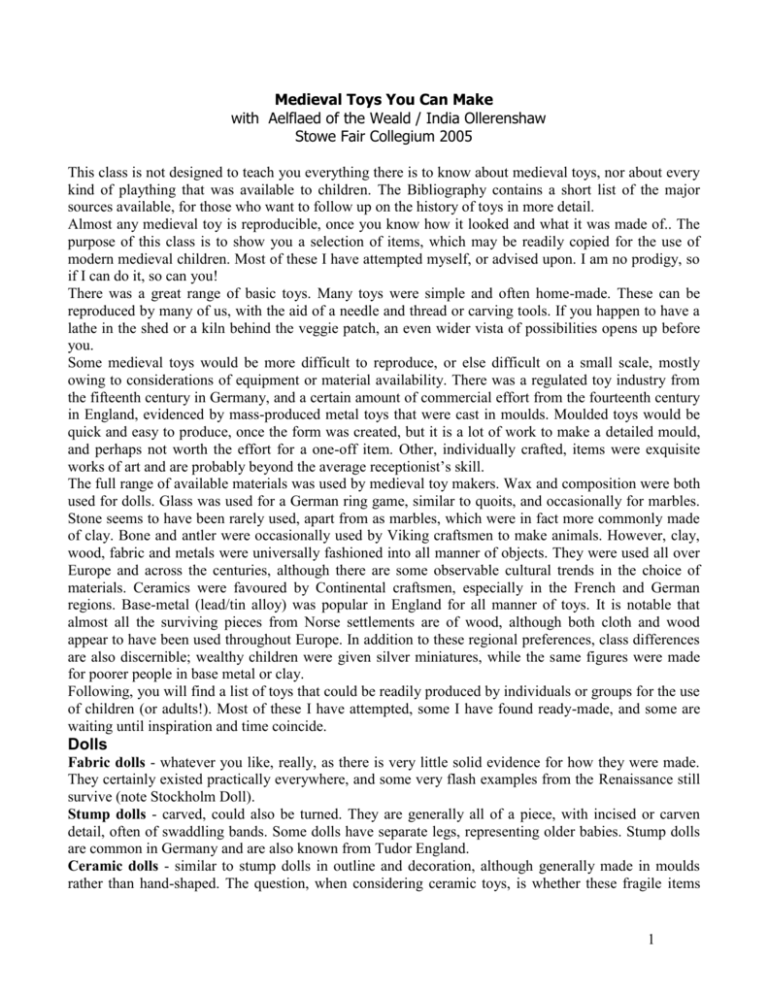
Medieval Toys You Can Make with Aelflaed of the Weald / India Ollerenshaw Stowe Fair Collegium 2005 This class is not designed to teach you everything there is to know about medieval toys, nor about every kind of plaything that was available to children. The Bibliography contains a short list of the major sources available, for those who want to follow up on the history of toys in more detail. Almost any medieval toy is reproducible, once you know how it looked and what it was made of.. The purpose of this class is to show you a selection of items, which may be readily copied for the use of modern medieval children. Most of these I have attempted myself, or advised upon. I am no prodigy, so if I can do it, so can you! There was a great range of basic toys. Many toys were simple and often home-made. These can be reproduced by many of us, with the aid of a needle and thread or carving tools. If you happen to have a lathe in the shed or a kiln behind the veggie patch, an even wider vista of possibilities opens up before you. Some medieval toys would be more difficult to reproduce, or else difficult on a small scale, mostly owing to considerations of equipment or material availability. There was a regulated toy industry from the fifteenth century in Germany, and a certain amount of commercial effort from the fourteenth century in England, evidenced by mass-produced metal toys that were cast in moulds. Moulded toys would be quick and easy to produce, once the form was created, but it is a lot of work to make a detailed mould, and perhaps not worth the effort for a one-off item. Other, individually crafted, items were exquisite works of art and are probably beyond the average receptionist’s skill. The full range of available materials was used by medieval toy makers. Wax and composition were both used for dolls. Glass was used for a German ring game, similar to quoits, and occasionally for marbles. Stone seems to have been rarely used, apart from as marbles, which were in fact more commonly made of clay. Bone and antler were occasionally used by Viking craftsmen to make animals. However, clay, wood, fabric and metals were universally fashioned into all manner of objects. They were used all over Europe and across the centuries, although there are some observable cultural trends in the choice of materials. Ceramics were favoured by Continental craftsmen, especially in the French and German regions. Base-metal (lead/tin alloy) was popular in England for all manner of toys. It is notable that almost all the surviving pieces from Norse settlements are of wood, although both cloth and wood appear to have been used throughout Europe. In addition to these regional preferences, class differences are also discernible; wealthy children were given silver miniatures, while the same figures were made for poorer people in base metal or clay. Following, you will find a list of toys that could be readily produced by individuals or groups for the use of children (or adults!). Most of these I have attempted, some I have found ready-made, and some are waiting until inspiration and time coincide. Dolls Fabric dolls - whatever you like, really, as there is very little solid evidence for how they were made. They certainly existed practically everywhere, and some very flash examples from the Renaissance still survive (note Stockholm Doll). Stump dolls - carved, could also be turned. They are generally all of a piece, with incised or carven detail, often of swaddling bands. Some dolls have separate legs, representing older babies. Stump dolls are common in Germany and are also known from Tudor England. Ceramic dolls - similar to stump dolls in outline and decoration, although generally made in moulds rather than hand-shaped. The question, when considering ceramic toys, is whether these fragile items 1 were meant to be played with, or were mainly display items. Ceramic heads were imported into England, presumably to be later attached to cloth bodies. Peg dolls - wooden pegs date from the 14th C. in London. They already look like people, so paint them and dress them to make dolls. Stump dolls are similar in shape, and perhaps this makes the leap from peg to doll a natural one. I see no impediment to the use of peg dolls in the modern medieval age. Edible dolls - figures made of gingerbread and sweetened gum tragacanth were sold, especially at fairs and on feast-days. They often represented a particular saint associated with the day. Some were gilded or painted, and some were hollow for a gift to be placed inside. Composition dolls - composition is a mixture of substances, mainly paper pulp. Arsenic was often added to keep off the rats that otherwise tended to destroy the dolls. Paper-maché would approximate the style. Later-period dolls were increasingly made of composition, although they often still had cloth bodies. Metal Figures - if you have access to casting facilities, silver, brass and pewter were often used to make toys. Articulated jousting knights were some of the most intricate metal toys made by medieval artisans. Flat and half-rounded metal figurines were also produced. Little tin soldiers are period. Animals Carved wooden animals, especially horses. Some were mounted on platforms, some had wheels, some are free-standing. Other animals - whatever period beast takes your fancy. Stick horses - Several kinds may be seen in paintings and illuminations. Some have the whole horse on the end of the stick, some have just the head. One is a kind of pool-horse, with a curtain hanging down all around the child to represent barding. There is no direct information on materials hobby horses could be constructed of wood, fabric or leather, possibly on a frame of wire or wicker (?), possibly stuffed with rags or moss. Metal and Ceramic figurines - All sorts of animals were made in ceramic or metal. Silver was popular for noble children, while lead-tin alloy was also common. Clay mythical beasties have been discovered. Toys training physical skills Balls - May be made of sewn leather, usually in three- or four-piece patterns. They were stuffed with pretty well anything, from pebbles and sawdust to wool scraps. Felt balls are easily made, soft for little ones, and probably period, although there is no archaeological evidence for them. Wooden balls were also common, especially in earlier times, and may be turned or carved. If you want to acquire a pig’s bladder and try inflating it, let me know how it goes. I’m not that keen, myself. Knucklebones - Get hold of pig’s knuckles, clean them and go for it. They are heavy, and larger than the plastic versions we are used to, so you’ll know about it when you catch one on the bones of your hand. You need five for a set. Jackstraws - dull the ends of a set of bamboo skewers, dye them and vóila! The colours represent different points values. My set has 30 sticks in total - 11 red, 11 yellow, 4 blue, three green and one. black. Their values are red - 10 points, yellow - 2 points, blue - 6 points, green - 4 points, black – 20 points. Some period sets were made of ivory, and had intricate carved figures at the tops to indicate the value of each stick. Skittles - carved, or more often turned on a lathe. Skipping ropes - too easy. A length of rope. Handles are nice, but optional. Medieval skippers used hoops (metal ones off barrels, possibly also wicker versions) and hemp stalks as well Wooden swords. These should be fashioned to resemble real swords of the appropriate period, with datable hilt shapes. I have no information on toy sheaths, nor on shields. Tops and spinners - carved, or turned if you have access to a lathe. Can be painted. Add a whip for whip tops, or a metal pin for peg tops. 2 Wind Toys Kites - A 15th C. German picture shows an Asian-style dragon kite being flown, and diamondshapes are also to be seen in the background. Propellers and Windmills - Both were made of wood. Paper windmills are documented in England. Noisemakers Ratchet rattles - slightly complex carpentry, but manageable. Find a pattern in a toymaking manual. Rattles - apart from the ratchet ones, simpler ones are made with a loose ball or beans inside a cage, whether of metal, wicker or even ceramic. They often have whistles in the handle, or ivory or coral inserted for teething infants to bite on. Buzzers - made of a strip of bone or wood with a hole in it, and a loop of thong or cord. A simple noisemaker. Miscellaneous Hand puppets - since we don’t have info about the plots of medieval puppet shows, do what you like. Punch and Judy is 18th C., but probably reflects what was done earlier to some degree. Household Items - small pots and jugs are common finds, either in metal or ceramic. There are occasional foodstuffs, such as the fish roasting on a grill seen in Egan. Furniture items are restricted to the occasional doll’s cradle, until dollhouses appear about 1600, with all their accoutrements. Masks - useful for scaring the neighbors. Probably made of paper pulp pressed into moulds. Papier-maché would be close to the same effect and is easy to make. Ribbon twirlers - The simplest method it to fix a length of ribbon to a stick. More complex modern versions use fishing bits…not sure what they are called …to allow the ribbon free movement. have no idea whether comparable bits were around in the Middle Ages. Wooden boats - There are quite a few finds of toy boats, some with masts. They are a feature of seaside cultures, particularly from northern European areas. Some are made of bark, some hollowed from a block of wood. Bibliography Egan, Geoff, Playthings From the Past: Lead Alloy Miniature Artefacts c. 1300 - 1800, Exhibition Catalogue, London, Jonathan Horne Publications, 1996. Endrei, Walter and Laszlo Zolnay, Fun and Games in Old Europe, Karoly Karoly Ravasz (trans.), Budapest, Corvina, 1986. Fraser, Antonia, A History of Toys, London, Weidenfeld and Nicolson, 1966. Gröber, Karl, Children’s Toys of Bygone Days: A History of Playthings of all Peoples from Prehistoric Times to the Nineteenth Century, (trans. P. Hereford) London, Batsford, 1928. Kolchin, B. A., Wooden Artefacts from Medieval Novgorod (trans.), BAR International Series 495, Parts I and II, 1989. Orme, Nicholas, Medieval Children, New Haven and London, Yale University Press, 2001. Ollerenshaw, I, Of Horses, Tops and Flanders Babies: Medieval and Renaissance Toys, 2005 (almost published) Tuttle, Kimberley (Margritte of Ravenscroft), Toys in the Middle Ages, published on Stefan’s Florilegium, 1999. (http://www.florilegium.org/ ) 3
